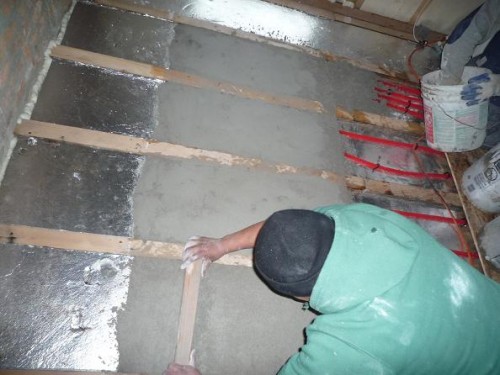We have a floor with a high ceiling which means we can lay the pex tubing on top of the subfloor instead of hanging the tubing beneath. The pex tubing takes up valuable space and you can only lay it on top of the subfloor if you have the ceiling height.
Having the tubing on top is better because the heat does not have to pass through the sub floor.
We laid stringers of wood 16 inches on center over the sub floor. They were about one inch high.
We put a look of pex tubing between the stringers.
How to Proofing Sound?
Then we covered the tubing with a mix of sand and structolite. This dense mass was added around the tubes for two reasons.
One it creates a good sound barrier between the two floors. And two it pulls the heat out of the tubes and into the room.
Structolite is a mix of plaster and perlite. Perlite makes it very light which is important since it is a wood joist floor. Perlite is also a good heat insulator, which is bad since we want the mass to pull as much heat out as possible. So we mixed it with sand which is a good conductor but heavier. It was basically a balance we had to find between weight and conductivity.
Stops Sound Between Two Apartments
We dry packed the mixture, meaning we used barely any water at all and packed it in manually instead of pouring it. Wood flooring is going over it so we didn’t want a wet mix that would take a long time to dry.
The end result is a nice warm floor that stops sound between the two apartments. Price was also a consideration. Sand and structolite are very cheap yet very effective in their uses here. The labour was a consideration since it took time to pack the mix in. But it still was much cheaper than any other combination that I can think of.
One important point is that we did not put any tubes or mass near the walls. Instead we put insulation. This is to keep the heat inside the house and create a dense insulation barrier between the heat and the cold. This keeps the house warmer and with a lower heating cost since less heat is lost to the outside.


